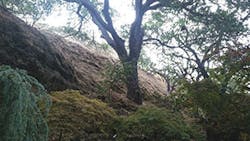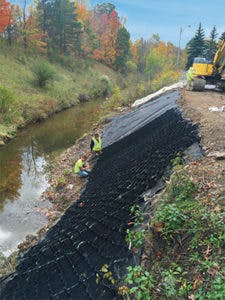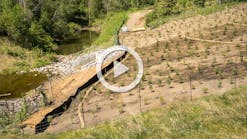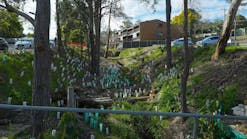From stabilizing failing slopes to creating new slopes, erosion control contractors are turning to new technologies as well as relying on the tried and true in a number of projects throughout the US.
Case in point: Governors Island is a 172-acre island located in the middle of New York Harbor, offering views of the Brooklyn Bridge and the Statue of Liberty. The island previously housed a US Army and Coast Guard base. In the past few years, the island has been repurposed to develop a commercial district as well as parkland.
The project entailed raising the island’s elevation for flooding resiliency and recreational purposes. Parkland was raised 7 to 9 feet.
In addition, crews installed four hills ranging in height from 25 to 70 feet and created from 297,000 cubic yards of fill.
“The hills were basically built out of scratch,” notes Brooke Schiavone, COO of Jobsite Products, which serves as the distributor of the Tensar North American Green products used on the project. “There was a lot of loose soil that they brought in. They had to go through several slope stabilization techniques to keep everything in place.”
The erosion control solutions were installed from spring 2015 to summer of 2016. The landscape contractor on the project was ValleyCrest, now known as BrightView.
Solutions used include BioNet C125BN, a long-term biodegradable double-net coir blanket from North American Green. Other solutions included custom-made wattles and HydraCX Extreme Slope Matrix.
The HydraCX Extreme Slope Matrix is a hydraulically applied mulch that includes a blend of mechanically processed straw fibers, reclaimed cotton plant materials, and tackifiers designed to enhance performance. The HydraCX matrix requires no curing for soil erosion protection and is designed to establish a bond upon application with the soil’s surface.
One of the biggest challenges was getting the erosion control materials to the island, notes Schiavone. After the company took delivery of all of the materials from Tensar North American Green, the process entailed traveling through Manhattan to catch a ferry that was early enough and large enough to accommodate Jobsite Products’ trucks transporting the material. Otherwise, the company’s crews would have had to catch the barge that contractor Turner Construction was running, which left from Staten Island.
“That would have been easier, but it cost them $8,000 a day to run that barge, so they did not like to do it very often,” says Schiavone.
The slopes on the project were significantly steep, Schiavone points out, adding that in some areas, crews had to go in a few times to apply materials. Because the project went on for almost a year, crews worked through varying weather patterns, including serious snowstorms, a lot of freeze, and high winds.
“There was moisture in the air since you’re basically sitting on the islands, so that’s why they had to use some of the more high-end materials,” says Schiavone. “They really didn’t skimp on anything. They put in 300,000 plantings. They were making their own biosoils on the island that they were using to reintroduce back into the soils. They had specialty seed mixes. After they installed the C125BN, they went in and cut through it and put in these plantings on all of the slope faces.”
The hills are of varying heights and bear different names. One has slides coming down the side of it. The tallest one has an observation point from which visitors can get a 360-degree view of the Statue of Liberty and Manhattan. Another hill features a sculpture created by a German artist.
After Greenax stabilization
Sliding in California
A residence in Lafayette, CA, backed up to a steep hillside where the sandstone bedrock on the slope is relatively shallow, with a layer of residual soil and rock fragments on top of it.
“The problem was that soil and rocks tended to migrate down the slope and onto the rear patio, and sometimes small rocks would hit the house,” notes Christopher Wilhite, chief engineer for Engineered Soil Repairs.
“The repair we recommended was to install Geobrugg Greenax erosion control matting over the area of the slope that was affecting the yard improvements—approximately 60 feet by 60 feet of the slope behind the house,” he adds.
Greenax integrates a three-dimensional polypropylene erosion control mat with high-tensile steel wire mesh, designed for use in temporary and permanent erosion control on slopes, embankments, and cuttings where the goal is to establish vegetation even in difficult climatic conditions.
In installation that lasted two weeks, crews first hand-seeded the slope with a native grass mix specific to Contra Costa County, then placed the matting. The Greenax was secured to the slope with rock bolts drilled 9 feet deep and grouted into 3-inch-diameter holes on 6-foot staggered grid spacing, says Wilhite.
The rock bolts were hand-tensioned to 160 foot-pounds of torque, which is about the equivalent of 7,000 pounds of tension, he adds. The approximate cost of the project was $30,000.
“The client was very happy with the repairs, and there have been no issues since the work was completed in 2016, even after the heavy rains we had in California over the winter,” he says.
The slope behind the California home
Road Reconstruction in Ontario
The details of a project can become complicated when it requires multiple grade changes, with construction time and costs increasing exponentially if the correct solution is not applied, notes Lynn Stocker, marketing manager with Strata Systems.
K. J. Beamish Construction Co. was tasked with reconstructing a section of Bathurst Street for the regional municipality of York in Ontario, Canada. The road needed widening to allow free-flowing traffic through a previously bottlenecked area.
Two mechanically stabilized earth (MSE) slopes with various facing elements needed to be installed, with one slope requiring installation over the top of a large culvert. Due to the area’s complicated geometry, the angle of inclination required a transition between the two slopes from 60 degrees to 45 degrees.
The Canadian market for MSE technology is very competitive, yet there often is not a single-source solution for a contractor needing multiple facing elements, says Stocker. Terrafix Geosynthetics was able to provide the contractor with the spectrum of reinforcement products required on the project by using Strata Systems as its source supplier.
Concrete infill was used in
some areas.
StrataGrid and StrataWeb were both used on the project, which was done in 2015 and 2016. StrataGrid is a soil reinforcement product designed with polyester yarns with a high molecular weight and significant tensile strength. They are knitted into a dimensionally stable network of apertures to form a geometric grid shape to offer tensile reinforcement to the soil in vertical and horizontal directions. The grid is coated with a black saturation coating designed to provide additional chemical and mechanical benefits for durability in any environment.
StrataWeb is designed for use in soil reinforcement and for load support over soft soils, erosion control on steep slopes, and the lining of lagoons, drainage channels, and landfills. The product utilizes strips of extruded polymer welded together at intervals; when expanded, it forms a three-dimensional honeycomb mattress. After the spaces are filled with granular material, the cellular confinement system is able to transfer compressive and tensile stresses from heavy loads to provide high load support capacity.
The design flexibility of Strata’s reinforced slope system enabled the project designers to seamlessly vary the batter of each slope and integrate the different facing elements using StrataGrid 200, 350, and 500, and 50,000 square feet of StrataWeb 356 8-inch geocell fascia wall panels.
The use of StrataGrid as the primary reinforcement for the StrataWeb-faced slope and the wrapped-faced slope allowed crews
to use onsite soils.
“With Strata as the sole source for the project’s soil reinforcement needs, the fully stabilized roadway was installed within the project’s allotted budget and time constraints,” notes Stocker.
Geoweb installation
Saving a Warehouse
A slope was failing near a warehouse located along Hawthorne Creek in Solon, OH, exposing the building’s foundation. The owner contacted Jon-Michael Lemon, manager of civil engineering at Osborn Engineering in Cleveland, OH, who then contacted Jerry Frantz, technical sales manager for Meredith Brothers, a civil engineering firm in Columbus, OH, whose company serves as a local distributor for Presto Geosystems.
Franz had had a previous discussion with Lemon about the use of Presto Geosystem’s Geoweb cellular confinement system for slope stabilization and retaining walls; Lemon asked if he thought this would be an appropriate solution for the failing slope.
The Geoweb slope and shoreline protection system is designed to confine, reinforce, and restrain the upper soil layer and infill, controlling downslope movement and slippage due to hydrodynamic and gravi-tational forces.
Geoweb utilizes virgin HDPE material in its construction, as well as I-slots designed for fast section connection and tendon threading. It is designed to create additional stability by integrating tendons on steeper slopes and shoreline embankments, or in situations where a hard soil or rock surface prevents anchoring a geomembrane with stakes. The product enables embankments to be steeper than when unconfined, reducing use of land space.
Franz agreed the failing slope would be an appropriate candidate for Geoweb GW30V4 and an engineer at Presto Geosystems came up with a solution for anchoring the system with earth anchors and tendons, he says.
The product allows a variety of infill materials based upon details of the specific project: topsoil with various selected vegetation; aggregates, including sand, gravel, larger rock, and stone; concrete of various strengths and surface finishes; and onsite available fill, as well as combinations of those materials to meet project conditions.
Franz says armoring was needed because of the site’s location near a stream, so the choice was made to go with a concrete infill in the cellular confinement system. Once filled, it becomes a flexible concrete mat with built-in expansion joints.
Fabrizi Trucking & Paving Company in Cleveland won the bid for the project and prepared the slope, built the foundation, placed the Geoweb, and filled it in with concrete. The project was completed by a four-person crew over two weeks in late fall 2016.
“They wanted to get this done before it was too hard to get to the site,” notes Franz. “It was a vegetated slope, and over time, you would have currents from the stream that were eroding its toe and the slope was starting to fail.”
Geoweb was chosen for its durability and ease of installation, particularly given that the site had tight access that didn’t allow for the use of large equipment do the work, says Franz.










